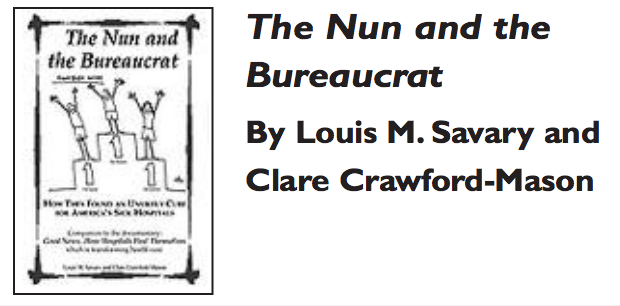
Acompanion to the PBS documentary, “Good News . . . How Hospitals Heal Themselves,” The Nun and the Bureaucrat: How They Found an Unlikely Cure for America’s Sick Hospitals by Louis M. Savary and Clare Crawford-Mason (CCM Productions, 2006) is the story of two large healthcare organizations that adopted systems principles as part of an effort to reduce death and suffering, medication errors and hospital-acquired infections, waste, and expense and to improve quality of care and working conditions for healthcare professionals. Forty hospitals cooperating in the Pittsburgh Regional Healthcare Initiative (PRHI) and 20 hospitals of the SSM Health Care system in St. Louis applied the management ideas of W. Edwards Deming —who helped the Japanese automotive industry become a world leader in innovation and quality—as they entered a continuous quality improvement effort. The book provides readers with the opportunity to learn about systems thinking and the processes—and difficulties— involved in developing that frame of mind. By offering detailed examples from the hospitals’ experiences, it brings the theoretical description of systems thinking to life.
TEAM TIP
Explore the question, “What is our shared purpose?” Doing so can help you turn a collection of people and processes into a whole greater than the sum of its parts.
The Path to Systems Thinking
The healthcare industry’s problems, the authors maintain, are not external—government regulations, insurance restrictions, competition from other providers—but internal—duplication of work effort, quick fixes to apparent problems, and miscommunications within organizations. To design truly sustainable solutions, the institutions realized that they needed to make the patient the focal point; the development of systems thinking then became much more feasible. As the authors point out, “Anyone familiar with systems thinking or Dr. W. Edwards Deming’s principles of quality management will know that the only thing that can turn a collection of people and machines into a true system, that is, make them a whole greater than the sum of their parts, is a shared purpose.”
The organizations started by recognizing that they are systems and that, as such, employees need to act collaboratively: to understand and behave in ways that reflect the interconnectedness of their institution. With the systems understanding and the focus on patients, the hospitals laid the foundation for their improvements. One of the more critical issues they identified was that of blame. Fault finding is inconsistent with a culture centered on quality; rather, efforts were redirected to problem finding. Organizational learning can occur only when problems are acknowledged, not when fingers are pointed.
The use of a “learning line” at PRHI, in which units experiment with others in the system to create improvements, also exemplifies organizational learning. This process operates on the understanding that adoption of a singular model across different areas may not work but that sharing ideas may lead to brainstorms for new ways of operating. Likewise, both institutions went outside their own organizational—and industry— boundaries to learn best practices. PRHI looked at automaker Toyota to help understand process improvement.
As systems thinking became more common in the organizations, practitioners described the phenomenon of seeing things from various perspectives. There was a transition toward focusing on the core purpose—serving the patient, finding connections rather than differences, looking for problems rather than hiding them, and thinking long term rather than seeking immediate solutions. The use of data and the sharing of that data between units was another change.
The Path of Improvement
The final section of the book discusses “The Path of Improvement” and provides specific steps taken. One of the keys to long-range, big-picture thought processes is root-cause analysis. The use of such tools allowed these organizations to understand issues systematically and to avoid the inefficiencies of “quick fixes.” Other quality improvement approaches are discussed, including the issue of employee empowerment. When the hospitals adopted processes that encouraged workers to raise issues and participate in creating solutions, problems were resolved much quicker.
These organizations are not presented as being perfect. The book describes the tension between the physicians’ perspective and that of the administrators. The physicians, like the patients, had at times been forgotten or lost in the operations (pun intended). Systems thinking, and the use of Baldrige quality criteria, required that the organization seek to understand internal as well as external stakeholders.
Systems thinking is often categorized as either overly simplistic or very complex, with multiple loops on loops. The anecdotes provided in this book bring with them an inspiration and a sense of encouragement for those who believe in systems thinking as critical to organizational success and improvement. The vivid examples make it a more palatable piece than many that deal only with the theory behind systems thinking, though that theory is well presented. Finally, as a boost to your own brainstorming for improvement, this book will provide many ideas that can be adapted to any setting.
Ed Cunliff (ecunliff@cox.net), Ph. D., currently serves as AVP for Academic Affairs at the University of Central Oklahoma. He has more than 30 years of experience in innovative organizational development. Ed has worked in social services, healthcare, and higher education and has served in a consultative role with dozens of organizations.
